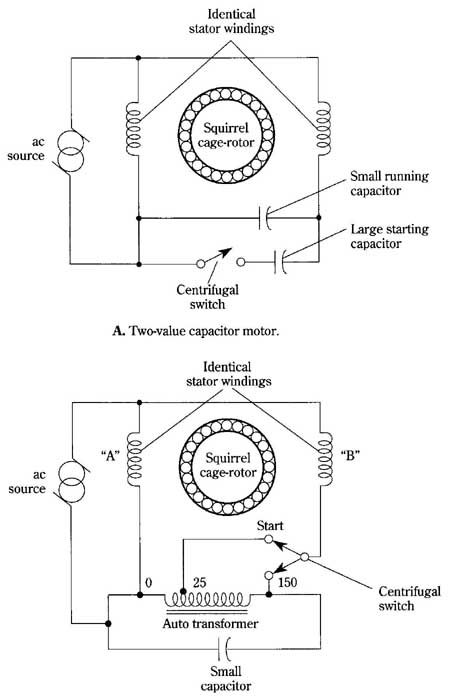AMAZON multi-meters discounts AMAZON oscilloscope discounts
.The starting torque of the permanent-capacitor, split-phase motor can be greatly in creased by the use of a capacitor whose value is much larger than that suitable for optimum running operation. It’s only natural, then, that the two-value capacitor motor is used where high starting torque and quiet operation at a high power factor are desired. The most obvious way to achieve this combination of desirable characteristics is to incorporate a centrifugal switch such as is used in the resistance-start and capacitor-start, split-phase motors. Starting is accomplished with the large electrolytic-type capacitor connected in parallel with the smaller oil-filled running capacitor. In the vicinity of 80 percent of synchronous speed, the centrifugal switch disconnects the starting capacitor. The motor then operates as a permanent-capacitor, split-phase type. The two stator windings are generally identical in these motors. The circuit for the two-value capacitor motor is shown in FIG. 12A.
An oil-filled capacitor tends to have a much longer life than an electrolytic type does, when subjected to the rather abusive conditions of motor starting. Therefore, some motors use a single oil-filled capacitor in conjunction with an autotransformer to attain the same effect found in the two-value capacitor motor. During the start interval, the centrifugal switch connects an autotransformer in the circuit so that the actual capacitance is effectively multiplied by the square of the turns ration of the transformer windings. This can be recognized as an impedance-transforming technique. The capacitor is momentarily subjected to a stepped-up voltage, but these Capacitors are readily designed for high voltage ratings. The overall scheme provides better reliability than that ordinarily obtained with electrolytic capacitors.
-- ---

FIG. 12 Two methods for obtaining high starting torque and smooth running. A.
Two-value capacitor motor. Identical stator windings; Small running capacitor;
- Large starting capacitor; Centrifugal switch; Small capacitor; B. Single-value
capacitor and auto transformer.
-- --
If the capacitor in FIG. 12B is a 10-microfarad, oil-filled type, and the auto-transformer has 150 total turns, with the tap at 25 turns, the capacitance “seen” by the motor during the starting interval will be:
(150/25)^2 x 10, or 360 microfarads
The capacitor voltage, assuming a 120-volt line, would be:
150/25 x 120, or 720 volts
In practice, a 1000-volt capacitor would be used.